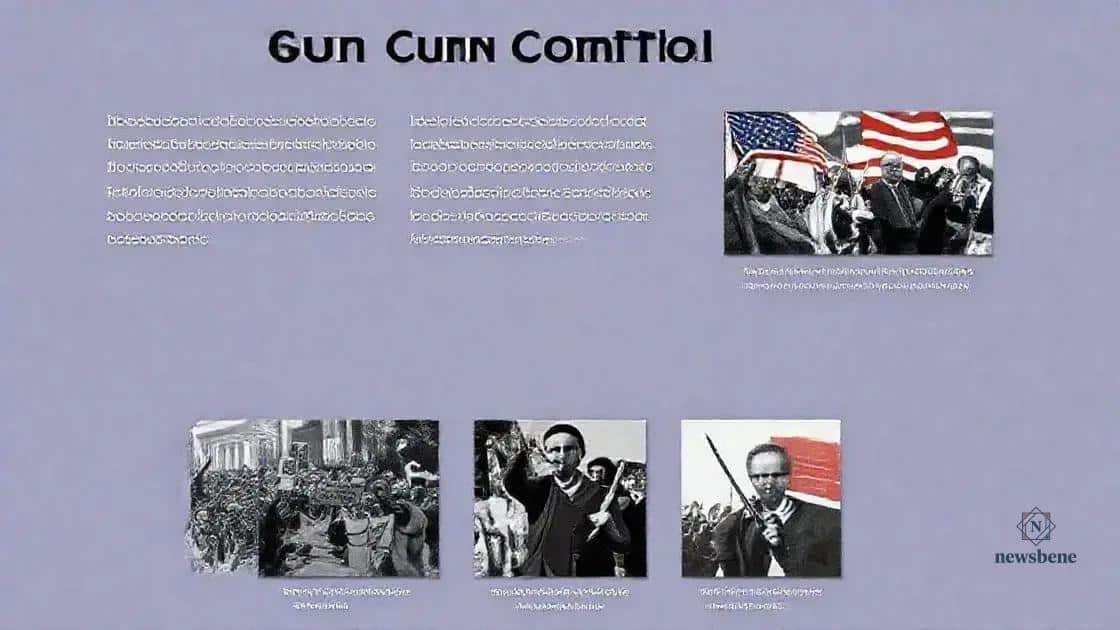Gun control legislation: understanding its impact and necessity

Anúncios
Gun control legislation aims to reduce gun violence and ensure responsible ownership through measures like universal background checks and the promotion of smart gun technology.
Gun control legislation is a hot-button issue that continues to stir debate across the nation. Many wonder how these laws affect our safety and rights. Let’s dive into this complex topic and uncover the various dimensions that influence public opinion.
Anúncios
What is gun control legislation?
Understanding gun control legislation is essential to navigate the discussions surrounding it. These laws are designed to regulate the ownership, use, and sale of firearms. They aim to enhance public safety by preventing gun violence and ensuring responsible ownership.
What does gun control legislation cover?
Gun control laws can vary significantly across different states and countries. However, some common elements are often included:
- Background checks for all firearm buyers.
- Restrictions on certain types of firearms.
- Licensing requirements for gun owners.
- Regulations on gun storage and safety measures.
Anúncios
These components work together to promote safety among communities and reduce the risk of gun-related incidents. The debate about these laws often centers around issues of personal freedom versus public safety.
Debates surrounding gun control legislation can evoke strong emotions, as they touch on the rights enshrined in the Second Amendment of the U.S. Constitution. Some argue that these laws infringe on individual liberties, while others believe that they are necessary for community protection.
Types of gun control laws
Gun control legislation can be categorized into various types, each addressing different aspects of firearm regulation:
- Universal background checks: A requirement that all buyers undergo a background check.
- Assault weapon bans: Prohibitions on specific types of high-capacity firearms.
- Red flag laws: Permitting temporary removal of guns from individuals deemed a risk to themselves or others.
- Waiting periods: Delays before a firearm purchase is finalized.
These regulations are implemented to control the sale and distribution of firearms and to help prevent access to guns by individuals who might use them dangerously.
The complexity of gun control legislation means that discussions must take into account various perspectives, balancing the right to bear arms with public safety demands. Engaging in dialogue about these laws can help foster a better understanding of their implications and the real-world effects they can have on communities.
Key arguments for and against gun control
Discussing the key arguments for and against gun control is crucial in understanding this contentious issue. Supporters and opponents often present different perspectives, which can lead to heated debates. Let’s explore these viewpoints and see how they shape public opinion.
Arguments in favor of gun control
Proponents of gun control argue that stricter regulations can significantly reduce gun violence and increase public safety. Here are some common arguments:
- Reduction in gun violence: Studies suggest that areas with stricter gun laws often experience lower rates of firearm-related deaths.
- Preventing access for at-risk individuals: Gun control measures can help keep firearms away from individuals who might misuse them, such as those with a history of violence or mental health issues.
- Promotion of responsible ownership: Regulations can ensure that gun owners are educated and prepared to handle firearms safely.
These arguments emphasize the importance of prioritizing safety over unrestricted access to firearms. Advocates believe that responsible laws can contribute to a safer society.
Arguments against gun control
On the other side, opponents of gun control often raise compelling points regarding personal freedoms and rights. Some key arguments include:
- Second Amendment rights: Many believe that the right to bear arms is a fundamental freedom that should not be infringed upon by the government.
- Self-defense: Supporters argue that owning firearms is essential for personal protection and self-defense against threats.
- Criminal access: Critics argue that gun control laws may only restrict law-abiding citizens while criminals will still find ways to obtain firearms illegally.
This perspective emphasizes the importance of personal liberties and the belief that responsible citizens should not have their rights limited due to the actions of a few.
The debate over gun control is complex, with valid arguments on both sides. Understanding these perspectives can lead to a more productive conversation about how to address issues related to firearm ownership and public safety.
Historical context of gun control laws

The historical context of gun control laws provides essential insights into how these regulations have evolved over time. The relationship between society and firearms has been shaped by various events and changes in public opinion.
In the early years of the United States, firearms were a crucial part of daily life. Most citizens owned guns for hunting and self-defense. However, as the population grew, so did concerns about violence and crime associated with gun ownership.
Key Milestones in Gun Control History
Several significant events have influenced the development of gun control laws:
- 1934 National Firearms Act: This law was enacted in response to gang violence in the Prohibition era. It aimed to regulate the sale of machine guns and sawed-off shotguns.
- 1968 Gun Control Act: Following the assassinations of major figures like Martin Luther King Jr. and Robert F. Kennedy, this act tightened regulations on the sale of firearms, including provisions for background checks.
- 1993 Brady Handgun Violence Prevention Act: This act instituted background checks for purchases from licensed dealers, aimed at preventing access to guns by felons and those with mental health issues.
Each of these milestones reflected a growing concern over public safety and the need for regulation as crime rates fluctuated.
Changes in Public Sentiment
Over the decades, public opinion about gun control has shifted. After major incidents of violence, there is often a surge in support for stricter laws. However, during periods of relative peace, many advocate for the protection of Second Amendment rights. These changes highlight the ongoing struggle between gun rights advocates and those pushing for stricter regulations.
In modern times, mass shootings have reignited discussions about the effectiveness of current gun control legislation. Movements like March for Our Lives have gained momentum, particularly among young people, calling for reforms. At the same time, gun rights organizations often assert that responsible ownership should not be punished due to the actions of a few.
Understanding this historical context allows for a deeper appreciation of the complex dynamics at play in the ongoing debate surrounding gun control laws in the United States.
Case studies: gun control effectiveness
Examining case studies on gun control effectiveness can provide valuable insights into how different regulations impact gun violence and safety. Various regions have implemented distinct gun control measures, leading to differing levels of success. Let’s explore some notable examples.
Australia’s Gun Buyback Program
After a tragic mass shooting in 1996, Australia introduced stringent gun control laws and a nationwide gun buyback program. This initiative led to the surrender of over 600,000 firearms. As a result, Australia has not experienced a mass shooting since then. The program is often cited as a successful example of how strong regulations can drastically reduce gun violence.
United Kingdom’s Firearms Act
In the UK, the Firearms Act of 1997 effectively banned handguns for private ownership. The country has seen a significant decline in gun-related homicides and injuries as a result. Studies suggest that strict licensing and ownership regulations contribute to the overall safety of the public, demonstrating a successful approach to gun control.
United States Examples
In the United States, various states have experimented with different gun control measures. For example, California has implemented stronger background checks and restrictions on assault weapons.
- States with universal background checks often report lower rates of gun deaths.
- Research indicates that states with stricter laws tend to have fewer mass shootings.
- Conversely, states with lax regulations sometimes struggle with higher rates of gun violence.
The contrasting outcomes across these regions reveal how effective gun control policies can have a notable influence on public safety.
However, the effectiveness of these regulations often sparks debate. Opponents of strict regulations argue that they infringe on individual rights while supporters stress the need for safety.
By analyzing case studies, it becomes evident that while no solution is perfect, some approaches have demonstrated positive results in reducing gun violence. Understanding these outcomes can inform future policies aimed at enhancing public safety.
Future directions for gun control legislation
The future directions for gun control legislation are a topic of ongoing debate and significant importance in today’s society. As gun violence persists as a pressing issue, legislators are exploring various approaches to create more effective laws.
One emerging trend is the push for comprehensive background checks across all firearm purchases. Many advocates believe that expanding these checks can help prevent guns from falling into the wrong hands. Some states have already adopted laws requiring universal background checks, and this movement may continue to grow as public support increases.
Technological Innovations
Technology is also playing a crucial role in shaping future gun control efforts. Smart gun technology, which allows only authorized users to fire a weapon, is gaining attention. This innovation has the potential to reduce accidental shootings and unauthorized use. Policymakers might encourage research and development of such technologies to enhance the safety of firearm ownership.
State versus Federal Legislation
The debate between state and federal regulation is likely to persist. States have differing laws, often leading to confusion and loopholes that can be exploited. Some experts advocate for a more uniform federal approach to ensure that regulations are consistent nationwide. This could address gaps in the current system and create a more robust framework for gun control.
- Red flag laws: These laws allow authorities to temporarily remove firearms from individuals deemed a risk to themselves or others. This emerging strategy could become more widely adopted as states recognize its potential benefits.
- Community-based programs: Initiatives focused on education and community engagement could provide alternatives to gun violence. These programs aim to address root causes and promote healing within communities.
- Data-driven policymaking: Using data and research to inform gun legislation can lead to more effective strategies. Policymakers might increasingly rely on evidence to guide their decisions about which measures to implement.
As society evolves, so does the conversation surrounding gun control legislation. By focusing on innovative approaches and community engagement, the future of these laws may reflect a balance between safety and individual rights.
FAQ – Frequently Asked Questions about Gun Control Legislation
What are the main goals of gun control legislation?
The primary goals include reducing gun violence, preventing firearms from getting into the wrong hands, and promoting responsible ownership.
How effective are universal background checks?
Studies suggest that universal background checks can significantly reduce the rates of gun deaths and improve public safety.
What role does technology play in future gun control?
Innovations like smart gun technology can help ensure that only authorized users can operate firearms, potentially reducing accidents and misuse.
How can community programs impact gun violence?
Community engagement and educational programs can address the root causes of gun violence and promote safer environments through prevention strategies.